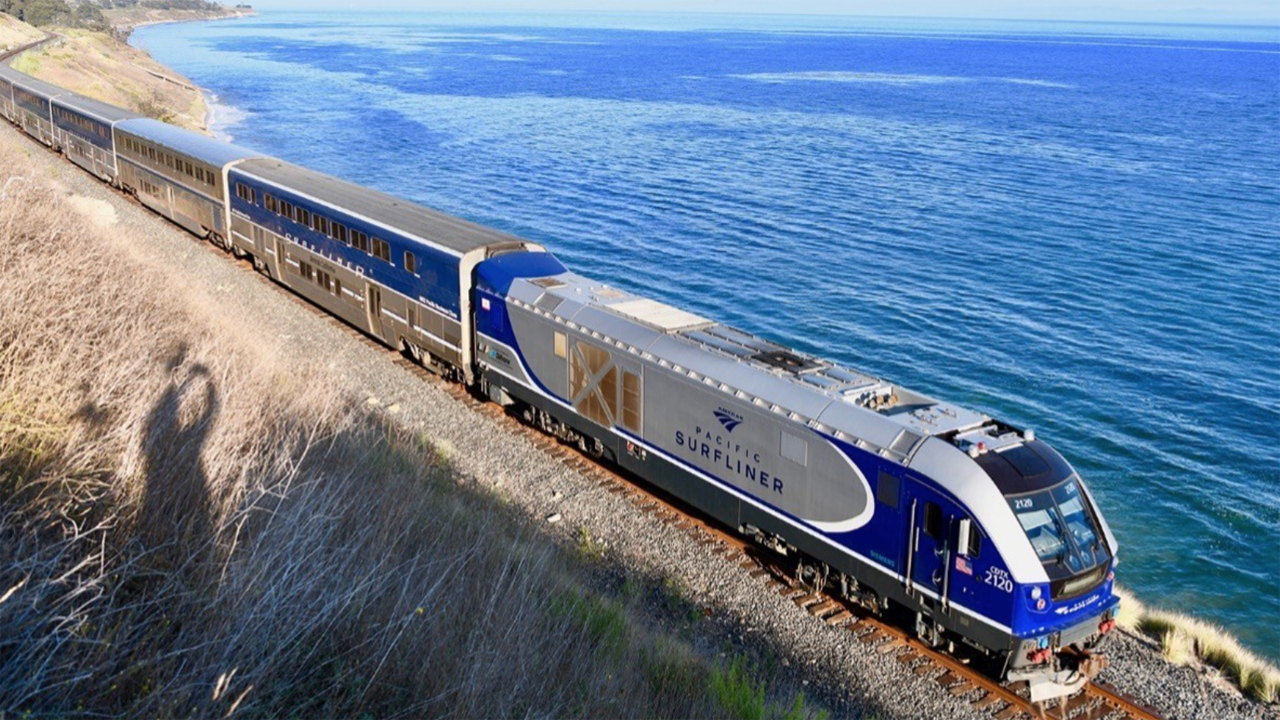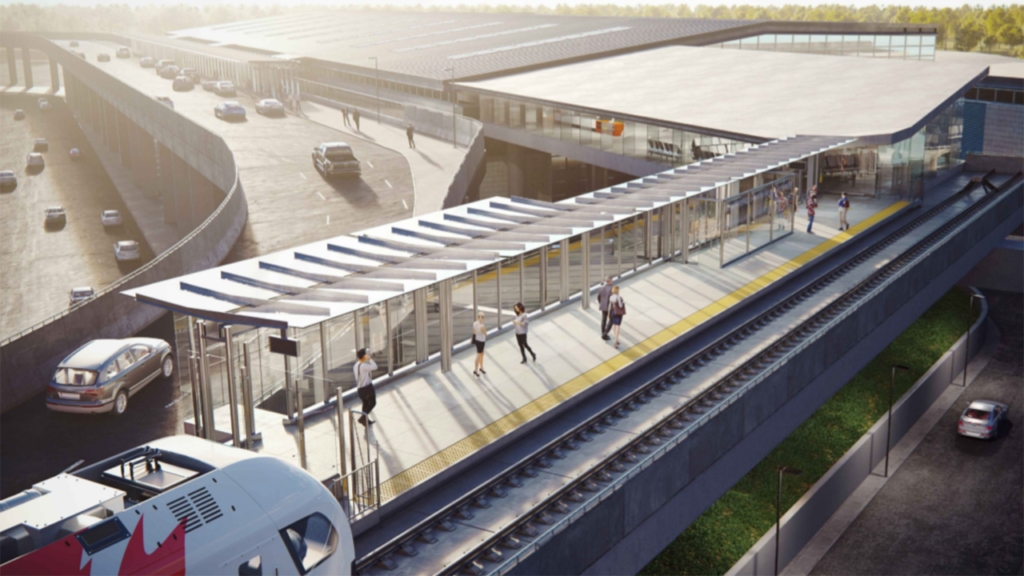
Transit Briefs: LOSSAN Rail Corridor, Clean California, Conn. State Bond Commission, Ottawa LRT
Written by Carolina Worrell, Senior Editor
California Gov. Gavin Newsom signs legislation incorporating climate resiliency into Los Angeles-San Diego-San Luis Obispo (LOSSAN) Rail Corridor planning. Also, California announces $114.5 million in Clean California grants; the Connecticut State Bond Commission announces $398.1 in state funding approved for the Northeast Corridor (NEC) Match Program and $15 million for New Haven Station improvements; and the Ottawa LRT north-south expansion line is delayed until spring 2024.
LOSSAN Rail Corridor
Gov. Gavin Newsom on Oct. 7 signed legislation by Sen. Caterina Blakespear (D-Encinitas) to require an assessment of the effects of climate change on the LOSSAN Rail Corridor.
According to the Office of the Senator, SB 677 directs the LOSSAN Rail Corridor Agency, which oversees the corridor in coordination with rail owners, operators and planning agencies, “to include the assessment in its annual business plan that outlines the agency’s major goals and objectives.” The assessment must also identify projects to increase climate resiliency and funding options for those projects.
Blakespear is Chair of the Senate Transportation Subcommittee on LOSSAN Rail Corridor Resiliency, which was established earlier this year to study how to improve infrastructure and service along the 351-mile rail line. The committee has held two hearings with a third scheduled for November.
The LOSSAN rail line—the second busiest intercity passenger rail corridor in the U.S.—serves six counties in Southern California with a population of approximately 20 million people and is “crucial to the movement of freight and passengers through the region.”
Over the past year, the rail line was closed to passenger service through San Clemente on multiple occasions for a total of nine months, due to hillside erosion jeopardizing the stability and safety of the tracks. Full service resumed in July after work was done to safeguard the tracks.
“I thank Gov. Newsom for signing SB 677 and ensuring that the LOSSAN Rail Corridor Agency is responding to, and planning for, the challenges created by climate change,” Blakespear said. “The LOSSAN rail line is vital to Southern California, and we must take steps to protect it from sea-level rise, coastal erosion and the other effects of our changing climate.”
“As an inter-city rail service spanning 351-miles, much of which is coastal terrain, climate resiliency is crucial for ensuring safe and reliable operations of the Pacific Surfliner service,” said Jewel Edson, Chair of the LOSSAN Rail Corridor Agency Board of Directors. “We appreciate the support of Governor Newsom and Senator Blakespear in helping the LOSSAN Rail Corridor Agency coordinate and plan for the long-term sustainability of rail service.”
Clean California
Gov. Gavin Newsom on Oct. 9 announced that cities and local agencies throughout the state will receive $114.5 million in grants to “remove litter, beautify neighborhoods and transform public spaces into points of pride.”
The funding is the latest piece of the governor’s $1.2 billion, multiyear Clean California initiative, led by Caltrans to remove trash, create thousands of jobs and engage communities to revitalize public spaces.
According to the governor, the 60 projects receiving funding will improve parks, tribal lands, neighborhoods, transit hubs, walking paths, streets, roadsides, recreation fields, community gathering spots, and places of cultural importance or historical interest in underserved communities. This funding builds on the nearly $300 million in grants to more than 100 local Clean California projects statewide that Gov. Newsom announced in March of 2022. Following the positive community response, Gov. Newsom and the state legislature approved another $100 million last year for a second round of local projects.
Grant examples include $3.3 million to the San Francisco Municipal Transportation Agency (SFMTA) to clean transit stations and bus stops throughout the city, $1 million to the San Diego Metropolitan Transit System (MTS) for South Bay Transit Beautification and $1.1 million to the City of Fullerton to enhance the Fullerton Transportation Center. This is part of a specific $14.5 million in funding set aside from the total announcement to support 18 projects to clean stations and other areas around public transit systems. In addition, there are 42 local grant projects ranging from $88,000 to $5 million, and all benefit underserved communities.
Since launching Clean California in July 2021, Caltrans has removed an estimated 1.9 million cubic yards of litter from state highways. The program has created more than 4,000 jobs that have helped Californians overcome barriers to employment, including 357 people who had been experiencing homelessness, and drawn more than 10,000 volunteers to events ranging from community cleanups to large debris collections for appliances, tires and mattresses.
“The trash we see on our roadsides and public areas is completely unacceptable – Californians deserve better,” said Gov. Newsom. “Cleaning up public spaces will help us restore a sense of pride and a sense of community throughout the state.”
Conn. State Bond Commission
The Connecticut State Bond Commission on Oct. 6 voted to approve more than $1.1 billion in state funding that will be used to perform various and widespread improvements to Connecticut’s transportation system.
The funding includes more than $666 million for public transportation and more than $300 million for roads and bridges. Specific projects approved for the funding include:
- Northeast Corridor (NEC) Match Program: $398.1 million for 13 projects aimed at upgrading outdated passenger rail infrastructure and improving transit efficiency, speed, and capacity. This allocation will provide a match for up to $2.1 billion in matching federal funding.
- New Haven Union Station Improvements: $15 million for the design of three enhancement projects to the property, including a new multimodal hub, parking structure, and rental car facility in the West Lot; Transit Oriented Development (TOD) in the existing East Lot; and the realignment of Union Avenue near Union Station to enhance traffic, bicycle, and pedestrian safety.
“The $1.1 billion in state bond funding we are releasing today positions our state to create the transportation network of the future, which will connect people to jobs, employment, and all our state has to offer,” Gov. Lamont said. “This funding will help bring upgrades to a wide variety of improvements across our transportation network, including roads, bridges, and public transit. Notably, it will support our ongoing goal of putting the infrastructure in place that will help reduce travel times between New Haven and New York. By leveraging all federal dollars available through the Bipartisan Infrastructure Law, we can bring significant improvements to our state’s transportation system while lessening the burden on Connecticut taxpayers.”
“By advancing these funds, Governor Lamont and the State Bond Commission are ensuring Connecticut residents will see a substantial increase in projects that will improve transportation access, grow the economy, increase safety and reliability, and improve quality of life,” said Connecticut Transportation Commissioner Garrett Eucalitto. “This funding is setting the stage for the next ten years of needed projects that will transform our infrastructure with improved roads and bridges and a robust multimodal transportation network that is accessible to everyone.”
Ottawa LRT
Ottawa’s light-rail transit (LRT) will not open its expanded north-south (Trillium) line until at least April 2024, a 20-month delay to the expected delivery date in the original contract, according to a report by The Canadian Press.
But OC Transpo head Renée Amilcar, according to The Canadian Press report, says that “in the name of caution, the transit agency is delaying a public opening, though it is seeking a handover from contractors as soon as possible.”
According to the report, Amilcar says “the decision means there will be more time to test the system and ensure proper training.”
“The extended Trillium Line will run south from Bayview Station, which is part of the city’s east-west transit line, past the Ottawa International Airport to Limebank Station near the Riverside South neighborhood,” according to the report.
Last month, the city estimated that “an eastward extension of the existing line is on track for 2025 and a westward expansion is expected to open in late 2026,” according to The Canadian Press report.

For background on the project, read: “Ottawa LRT Projects Advancing,” a report by Railway Age Canadian Contributing Editor John Thompson.



